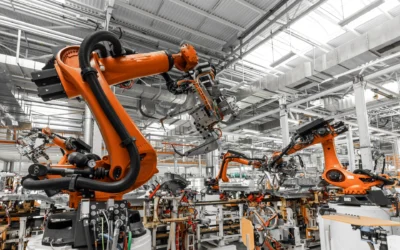Connecting Design with Manufacturing Performance
The role of design in manufacturing is sometimes overlooked, yet it plays a pivotal role that significantly impacts product quality, manufacturing costs, and overall manufacturing efficiency.
With growing competition and higher consumer expectations, product design has become more than just a creative task—it’s now a strategic component that can make or break a product’s market performance. Learning from successful design implementations can provide valuable insights and tips on how to refine design strategies for manufacturing.
The Importance of Effective Design in Manufacturing
Effective design goes beyond just appearance and aesthetics; it’s about creating products that meet the desired specifications, function efficiently, and can be produced cost-effectively.
Here’s why design plays a critical role in manufacturing:
- Improved Product Quality:
A well-thought-out design ensures that the final product meets or exceeds customer expectations. It addresses potential issues before they arise, reducing the likelihood of defects and enhancing overall product quality, even when dealing with complex parts and materials like metal or plastic. - Cost Reduction:
Efficient design minimises waste, reduces material costs, and optimises production processes. By identifying potential bottlenecks and inefficiencies early in the design phase, manufacturers can avoid costly revisions and delays during production. - Enhanced Manufacturing Efficiency:
A product designed with manufacturing in mind can be produced more quickly and with fewer resources. This not only speeds up the production process but also reduces labour costs and improves the overall efficiency of the manufacturing operation. - Sustainability:
As environmental concerns become increasingly important, sustainable design practices can help manufacturers reduce their carbon footprint. By designing products with recyclability and energy efficiency in mind, companies can contribute to a more sustainable future while also appealing to environmentally conscious consumers.
Successful Design Implementations Example
To better understand the impact of effective design in manufacturing, there are no better examples than to examine leading companies that have long relied on this design strategy to fuel their success over the years.
1. Apple Inc. – The iPhone
Apple is renowned for its emphasis on design, and nowhere is this more evident than in the iPhone.
From the sleek form factor to the intuitive user interface, every aspect of the iPhone’s design is meticulously crafted. However, what sets Apple’s design process apart is its integration with manufacturing.
Apple’s process of designing starts with advanced Computer-Aided Design (CAD) tools to develop detailed iPhone models, which are then precisely manufactured by Computer Numerical Control (CNC) machines. The combination of CAD and CNC technology enables Apple to produce consistently high-quality products at scale, reducing defects and sustaining their industry-leading reputation.
Source: Kingpin-manufacturing
Key Takeaway: By aligning product design closely with manufacturing capabilities, Apple ensures that its products are not only visually appealing but also cost-effective to produce and highly reliable.
2. Toyota – Lean Manufacturing and Design for Manufacturability
Toyota’s approach to design is a classic example of how design can drive manufacturing excellence. The company’s philosophy of “Design for Manufacturability” (DFM) ensures that products are designed with the manufacturing process in mind, addressing complexity early. This approach is a cornerstone of Toyota’s lean manufacturing system, which focuses on minimising waste and maximising efficiency.
For instance, Toyota’s engineers work closely with manufacturing teams during the design phase to ensure that each component can be produced efficiently and assembled with minimal effort. This collaboration has led to significant cost savings, reduced production times, and higher-quality vehicles.
Source: Toyota
Practical Tips for Improving Design Processes in Manufacturing
Sometimes, the most impactful changes in manufacturing come from small and thoughtful adjustments during the design phase. Here are some practical tips:
- Leverage CAD and Simulation Tools:
Modern CAD tools are invaluable in the design process. They allow engineers to create detailed 3D models, simulate how a product will behave in the real world, and identify potential issues before production begins. By using CAD software, manufacturers can optimize designs for performance, durability, and manufacturability. - Implement Design for Manufacturability (DFM) Principles:
DFM is a design approach that focuses on creating products that are easy to manufacture. This involves considering factors such as material selection, assembly processes, and production tolerances during the design phase. By designing with manufacturability in mind, companies can reduce production costs, improve quality, and speed up time-to-market. - Adopt Rapid Prototyping Techniques:
Rapid prototyping allows manufacturers to create physical models of their designs quickly and cost-effectively. This can be particularly useful for testing form, fit, and function before committing to full-scale production. 3D printing, for example, has become a popular tool for rapid prototyping, enabling designers to iterate and refine their designs more quickly. - Foster Collaboration Between Design and Manufacturing Teams: Effective communication and collaboration between design and manufacturing teams are crucial for successful product development. By working closely together, these teams can identify potential issues early, share insights, and ensure that the final design is both innovative and practical to produce.
- Continuously Improve and Iterate:
The design process should not end once production begins. Continuous improvement is key to maintaining a competitive edge. By regularly reviewing and refining designs based on feedback from the manufacturing floor, companies can enhance product quality, reduce costs, and stay ahead of the competition.
By leveraging tools like CAD, adopting Design for Manufacturability principles, embracing rapid prototyping, fostering collaboration, and committing to continuous improvement, manufacturers can enhance their design processes and achieve better results.
Leading companies like Apple and Toyota demonstrate the importance of integrating design with manufacturing. These companies have shown that when design is closely aligned with manufacturing capabilities, the result is a product that excels in quality, cost, and performance.
When looking to improve design processes, the key is to embrace a holistic approach that considers every stage of the product lifecycle—from initial concept to final production. This strategy not only aligns products with customer expectations but also supports long-term business success.
Explore more related content
The Innovations that Shaped Manufacturing
The Innovations that Shaped Manufacturing in 2024 Every year, different trends drive every industry, and manufacturing...
Intretech Shines at PMI Supplier Summit: A Collaborative Vision for Excellence
Intretech Shines at PMI Supplier Summit: A Collaborative Vision for ExcellenceIntretech Ltd, a forerunner in the...
How is Generative AI Shaping the Future of Manufacturing Design and Prototyping?
How is Generative AI Shaping the Future of Manufacturing Design and Prototyping?The use of artificial intelligence...







